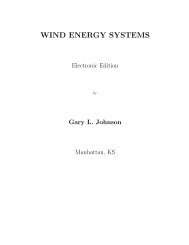Small Scale Foundries for Developing Published by: Intermediate ...
Small Scale Foundries for Developing Published by: Intermediate ...
Small Scale Foundries for Developing Published by: Intermediate ...
Create successful ePaper yourself
Turn your PDF publications into a flip-book with our unique Google optimized e-Paper software.
equire support on sand or metal <strong>for</strong>mers<br />
until they are baked.<br />
Other natural organic materials are used<br />
alone or in conjunction with hardening oils<br />
and include starch, flour, molasses, or sugar<br />
derivatives. Many types of flour when mixed<br />
with water provide a suitable medium <strong>for</strong><br />
bonding sand to produce cores. A disadvantage<br />
is that starch-bonded cores tend<br />
to produce large quantities of gas on<br />
pouring, Frequently a mixture of starch and<br />
oil is used to give a combination between a<br />
workable sand be<strong>for</strong>e curing and a hard and<br />
strong core after heating. It is possible to<br />
purchase specially prepared core binders<br />
and oils. Some of these oils are based on<br />
mineral oils and on fish oils as well as on<br />
natural vegetable oils. Ir is worth carrying<br />
out experiments with locally available oils as<br />
these may provide more economical corebinders<br />
than purchased, specially produced,<br />
proprietory materials. A typical mixture<br />
might contain 2% oil, 1 YZ % starch, and 2%<br />
to 3% of water. Such cores should be cured<br />
<strong>by</strong> baking at 250°C <strong>for</strong> approximately 45<br />
minutes in an oven.<br />
These oil-bonded sand mixtures may also<br />
be used <strong>for</strong> moulding when particularly<br />
strong moulds are needed.<br />
The mixing and preparation of coremaking<br />
sand must be carefully carried out. It is<br />
usually unsatisfactory to attempt to mix<br />
sand <strong>by</strong> hand, and a smail sand mixer of the<br />
type used <strong>for</strong> mouiding sand, or even a<br />
concrete mixer type, should be used. The<br />
composition of core sand mixes must be<br />
carefully controlled either <strong>by</strong> weighing or <strong>by</strong><br />
measuring the ingredients. Cores which are<br />
cured <strong>by</strong> heat or <strong>by</strong> the passage of CO, gas<br />
must be made under controlled conditions.<br />
CO2 process sand hardens slowly in the air,<br />
so that to avoid waste it should be mixed in<br />
small batches as it is required.<br />
Mixers must be cleaned after use to avoid<br />
contaminating other batches.<br />
Coremaking<br />
Cores may be made in metal, wooden or<br />
plastic core boxes. These core boxes are part<br />
of the pattern equipment <strong>for</strong> the castings.<br />
The simplest method of making cores is to<br />
ram the sand into the core box with a<br />
wooden rammer. Many cores may need<br />
rein<strong>for</strong>cement with wire or nails in order to<br />
provide internal support. Coremaking <strong>for</strong><br />
complicated shapes is a skilled process<br />
requiring several months of training,<br />
although simple cores can be made after a<br />
few days or weeks of practice.<br />
An alternative method of producing cores<br />
is to blow the sand into the core boxes. Core<br />
blowing machines can be bought which are<br />
suitable <strong>for</strong> both hot and coid core making<br />
processes. A range of machines is available<br />
from simple manually-operated blowers up<br />
to fully automatic equipment <strong>for</strong> the production<br />
of intricate cores on a large scale.<br />
Such coremaking machines require compressed<br />
air, power or gas services and maintenance,<br />
and can usually only be justified<br />
<strong>for</strong> repetition castings in conjunction with<br />
mechanised mould production.<br />
Cores that have been bonded with oil,<br />
starch or some resins must be cured be<strong>for</strong>e<br />
use. Core stoves may be fired <strong>by</strong> oil, <strong>by</strong> gas,<br />
<strong>by</strong> coke, wood or other suitable fuels. It is<br />
important that air should be allows3 to<br />
circulate within the stove since the curing<br />
process is <strong>by</strong> oxidation as well as <strong>by</strong> the<br />
application of heat. It is necessary <strong>for</strong> the<br />
core stove to have reasonably accurate<br />
temperature control.<br />
Core Assembly Moulding<br />
Coremaking methods are sometimes used to<br />
produce complete moulds. The mixer filler<br />
or air-set moulding process described above<br />
is one such example, but most coremaking<br />
processes can be used <strong>for</strong> moulding with the<br />
advantages of flexibility, rigid moulds, easy<br />
stripping, and absence of the need <strong>for</strong> moulding<br />
boxes. Moulds made from assemblies of<br />
cores have to be securely clamped and sealed<br />
together be<strong>for</strong>e pouring the metal.<br />
Coremaking sands are usually more<br />
expensive than moulding sands, so coremoulding<br />
is only used when there are<br />
definite technical advantages.<br />
29














